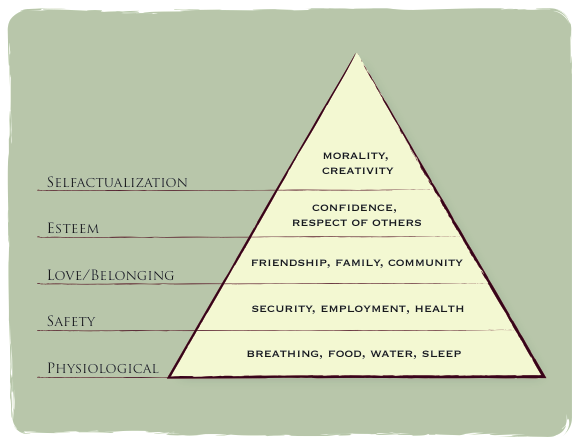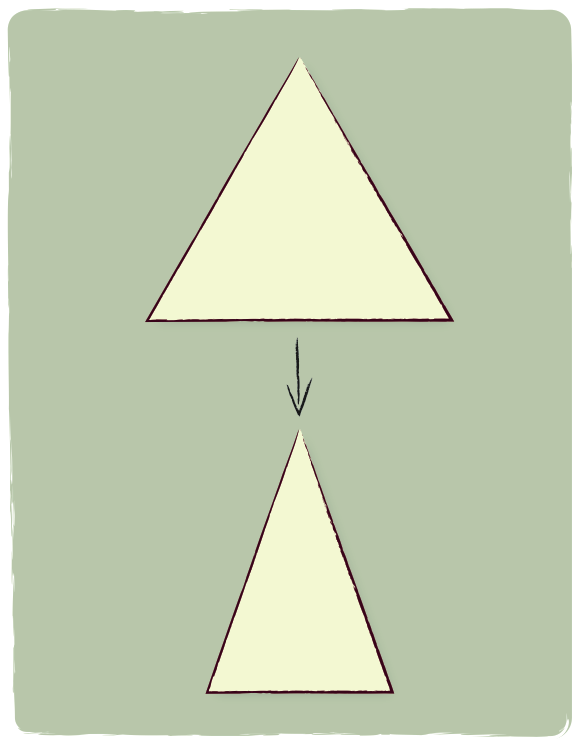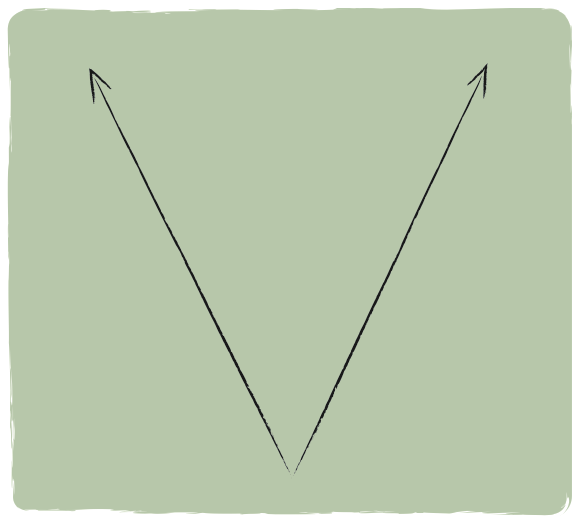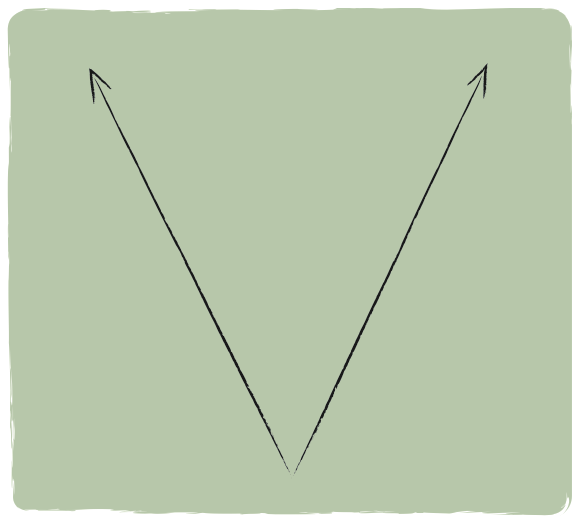Humans are motivated in their actions to satisfy needs. Needs are what drives people. People’s needs should also be what drives the economy. Starting from the needs of individuals and not starting from the needs of an economic theory or the needs of a financial system.
So, what do we need? Abraham Maslow, an American psychologist studied the human needs and is most remembered for the hierarchy of needs. The hierarchy of needs is most commonly presented as follows:

The more basic needs like housing and food are at the bottom of this hierarchy. When we fulfill these basic needs we can move on toward higher needs like friendship and community all the way toward the fulfillment of spiritual and creative needs.

PROGRESS
Progress brings economic efficiencies that make it possible to create more with fewer resources and less time ( e.g inventions like the wheel, the engine, the computer and productivity gains in general). This should make it possible to fulfill more needs with less effort. This makes it possible to narrow the bottom in our hierarchy of needs.

MORE NEEDS FULFILLED WITH LESS
For instance, technologies like the Internet have transformed access to information, music and communication and have created many options for our creative needs.
These new technologies are a boost to producers of knowledge, music, video and entertainment. We can now become creators with little capital. We could, as an example, start an Internet comedy channel from our basement with a potential global audience. Equipment like basic cameras that would have been professional equipment a generation ago are now available for amateurs, hobbyists and professionals alike.
This is an opening to self-actualization made possible by our progress: the success of entrepreneurial activities and technological advances that liberate resources, effort and time.

Individuals who have a drive toward higher needs, such as artistic pursuit, are motivated to narrow the ‘basics’ bottom of this hierarchy of needs and liberate time and resources to become creators. They will satisfy the basic needs like housing and food in such a way that they can concentrate on their creations or artistic expression. A similar process will take place for someone with spiritual needs, intellectual needs or other higher needs. At the end of this process the hierarchy would look more like this.

The efficient satisfaction of the lower needs leaves more room for the fulfillment of the higher needs like community, confidence and self-actualization and toward an unlimited reservoir of higher needs.
A CONUNDRUM
But our economic theory, with a need for monetary growth, runs into conflict with the human needs for growth. Once the basic needs are met we can either keep expanding them or we can move on to higher needs. In general, these higher needs require less money. Our needs for friendship, community and spiritual needs are less monetary. The result is a conflict between our money system that needs to create more money in order to sustain itself and the individuals who want to grow toward higher levels of prosperity that are less money oriented.
The process toward personal growth is disturbed by outside influences that create more wants for the same basic needs. These wants are materialistic and their creation is motivated by economic profit. Advertising and marketing is mostly aimed at stretching our motivations towards the satisfaction of the lower and more basic needs.

By the fixation on monetarily-intensive lower needs, there is less room for growth into the higher needs. We are stuck. By stretching the pyramid more horizontally we stay on a basic level instead of growing to higher levels that are often less monetary. Over the last decades, in the United States, we have been building super sized houses while smaller houses are sufficient to meet our housing needs. This has created higher mortgage and utility payments. The result is that we are stuck in extended basic needs; more ‘need’ for income and resources and thus work and time. This results in less time and resources for other higher needs like going for a walk in the park to enjoy nature or taking the time to find and read an inspiring book or spend time with family or friends.

AWARENESS
With awareness we can actively pursue our own interest in having a more fulfilling life. Without awareness, we could be guided by outside forces to a life as a consumer of only the basics.
Billions of dollars each year are spent to influence our decisions and it is not easy to escape their influence. Without this influence would millions of people make the choice to live under perpetual debt? Would millions of us choose to be obese or diabetic? Unfortunately there is less marketing and advertising to promote our higher needs. That promotion has to come from within.
NO LIMITS TO GROWTH (no limits to personal growth – no limits to people prosperity)
The current conditions of progress should allow for a pyramid structure that looks like this:

The pyramid is now open-ended at the top with no limits to growth. There is no end in sight for the growth so we might as well enjoy the process. Progress and the productivity gains of the last centuries make it possible to fulfill the basic needs with less time and resources. The higher needs like friendship, community and spirituality are mostly non monetary and non-material.
By presenting progress in an open ended upside down pyramid, there is no longer a feeling that each higher level is for fewer and fewer people or just for an elite. It is wide open for all of us. There is more room higher up than at the bottom. There is no scarcity on the higher levels as community, spirituality and relationships have no natural or monetary limitations. We benefit from each other’s progress and this contributes toward the sharing economy (with …..no limits to growth).









